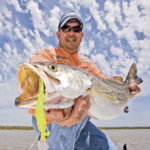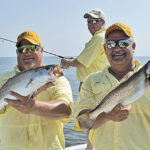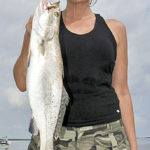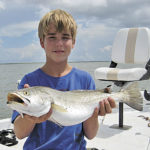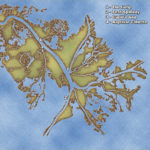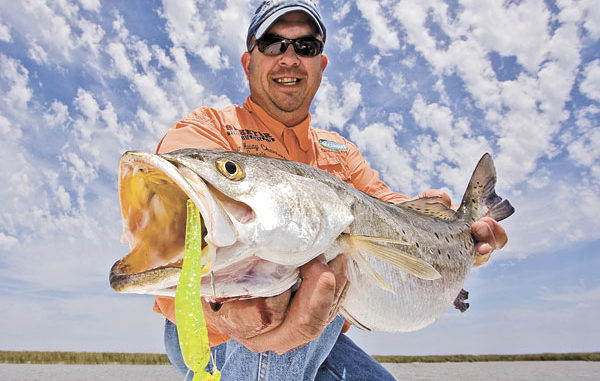
Sure November’s temperatures can be chilly, but the action at these four Venice spots is smoking hot.
If you’re deepfreeze is anything like my family’s, it takes you a while to dig through all the leftovers on top just to get to the good stuff underneath. Deer sausage, duck breasts and speckled trout fillets always seem to somehow fall deep down into the farthest reaches of the giant boxes.To say that Venice is kind of like a deepfreeze would be somewhat of a stretch since the temperature in south Plaquemines Parish rarely drops below 32 degrees. However, Venice this time of year does share at least one characteristic with my Kenmore. If you want to get to the good stuff, you’re going to have to look deep.
Although the reason for speckled trout moving into deepwater holes in the Mississippi River may never be known, the educated guessers who launch their bay boats out of Venice Marina have a pretty good grasp of what’s taking place and why.
According to Capt. Cade Thomas with Run-Away Charters, to think trout location in deep water has to do with anything other than where they can get something to eat would be a false assumption at best.
“If the water is low during the winter, it allows all that salt water from the outside to move into the river,” he said. “That brings in a bunch of bait, and the trout follow. When the water starts cooling, it pushes everything down. Salt water being denser than fresh water, it has a tendency to settle into all the deep holes, and that’s where we find the best winter fishing.”
As long as the Mississippi River is low and green, Thomas says any of these four spots should be among the most productive speckled trout holes in all of coastal Louisiana.
The Jump
Perhaps no deep-water hole in Venice exemplifies just how good winter trout fishing can be in the Mississippi River than The Jump. As you leave Venice Marina and head out past all the commercial traffic into the river, The Jump is the last 1/4 mile or so to your right just before entering the river.
“The water is about 60 feet in the middle of The Jump, but you want to get in about 20 to 30 feet to fish it effectively,” said Thomas. “That’s your target range. There might be some barges tied up on this side, but they aren’t going to interfere with your fishing.”
Throughout this entire stretch, there is about a 4-foot flat that extends just a few feet before it drops straight off into about 20 feet of water. A shelf extends a few more feet at the bottom of the initial drop, and then it drops off into about 30 to 35 feet. From there, it finally drops off into 40 to 60 feet.
“Trout could be just about anywhere along any of those drops,” Thomas said, “but they tend to be in about 20 feet most of the time. You’ve really got to anchor with all the water that comes through there, and I like to try to drop mine in about 40 feet.”
Thomas says he likes to drop purple/chartreuse soft plastics on 1/2-ounce jigs all the way to the bottom; then he fishes it out of the back of his boat. With the current pulling his lure away from his boat, he can bounce it up and down for as long as he wants without moving it from the strike zone.
“It’s kind of like vertical-jigging, but you’re doing it out of the back of your boat,” he said. “If I fish it on bottom very long without any bites, I’ll pull it up a few feet and do the same thing to check if the fish are suspended. Don’t be surprise if you find them suspended in 10 feet over 20 to 30 feet of water.”
First Spillway
As one of the more-popular spots in the entire Mississippi River delta when the fish show up, the first spillway can get a little crowded with boats, especially during the weekends. However, all those boats are there for a reason, and Thomas says there is generally room for everybody to get in on the action.
“When you go through the cut in the rocks, you’re going to hit about a 100-foot hole,” he said. “As you keep motoring back toward the canes in the distance, the water will come up to 30 feet in a heartbeat. You want to fish 20 to 30 feet, so I drop my anchor as soon as I see 30, and it normally catches by the time I hit 20.”
Although this dramatic depth change attracts lots of trout and anglers, Thomas said that the insides of the rocks where they hit the shoreline could also be great places to fish. The stretch to your left as you enter the cut has about a 40-foot drop, and the stretch to your right has a big shelf that concentrates lots of trout.
The ideal way to fish this spillway is to move around until you find a concentration of trout. However, if there are already a few boats fishing when you get there, Thomas says the best way to fish is to pick a spot, anchor and wait your turn.
“Those fish move around in there a lot, and they’ll eventually come around to you,” he said. “Rather than get in there and tick everybody off moving around everywhere, just pick a spot and go with it. Get a purple/chartreuse jig or a Carolina-rigged shrimp out there, and stick with it.”
The water coming through the opening in the rocks can get very turbulent, and Thomas says if the tidal range is over a foot and a half, it’s almost impossible to fish the spillway because of the sheer volume of water pouring from the river through the cut and into Zin Zin Bay.
Cubit’s Gap
Thomas was reticent to discuss Cubit’s Gap but not because he was trying to keep it a secret. It would be a little difficult to keep the head of Main Pass a secret. Rather, he thought it might be such a big, intimidating area that anglers would do better to focus elsewhere.
“Cubit’s Gap is where Main Pass leaves the Mississippi River,” he said. “The entire area is about a mile of water that you have to cover to really get on the fish. You can anchor when you find them, but you’ll do best if you drift the area first to find the fish.”
As you pull into the head of Main Pass, Thomas said to look for a channel marker on the east side of the river just before the opening of Main Pass. From there, drift right through the middle of Main Pass back toward Octave Pass.
Thomas says you’ll find one deep hole that’s about 25 to 30 feet deep with everything else running somewhere from 10 to 15 feet. Sometimes the fish set up in the shallower water, but Thomas typically finds them somewhere in the deeper water.
“It doesn’t look like anything you would want to fish, but there must be a bunch of bait that stacks up in there or something,” Thomas said. “I’ve seen birds diving over there this time of year; that tells me there’s a bunch of bait there.”
Thomas compared fishing the head of a pass like Cubit’s Gap with fishing the mouths of the passes during the spring. Whereas the best fishing during the spring is where the passes blow into the bays, a lower river, saltwater intrusion and bait moving up the passes creates the exact opposite situation.
“You fish the beginning rather than at the bay,” Thomas said. “It can get a little swift if we get a big tide, but it’s not quite as bad as you would get over there at The Jump because the mouth of Main Pass isn’t nearly as constricting to the water flow. And if you don’t have the patience to fish plastics for a mile, put on some live bait.”
Baptiste Collette
The head of Baptiste Collette is the same kind of situation at Cubit’s Gap. Rather than fish the mouth of the pass where it dumps into a bay, anglers concentrate at the head of the pass where it exits the Mississippi River.
“Baptiste Collette is right across the river from The Jump,” Thomas said. “And there are two significant differences between it and Cubit’s Gap. First, the channel is a lot deeper — 60 feet in some places. And this pass gets a lot more crew- and supply-boat traffic. That’s why they keep it dredged.”
Even though Baptiste Collette offers 60-foot water, Thomas says you don’t want to even think about fishing that deep. Rather, he recommended spending most of your time in 20 to 30 feet. Drifting is a good way to get on the fish, but get your anchor out when you get on the bite.”
Thomas also pointed out that the bank to your left as you enter the head of Baptiste Collette remains 20 feet for a good distance down the pass, and it frequently holds lots of trout. He also suggested making a drift from the channel market on the right side just as you enter Baptiste Collette down to an old generator house.
“There’s a 10- to 15-foot flat between the marker and the generator house where we catch a lot of fish during the winter,” he said.
The Mississippi River at Venice may not ever get cold enough to send you searching for your cold-weather gear, but if you fish these four deep holes this winter, you’re going to burn through a lot more freezer paper. Just make sure to keep the good stuff on top.
